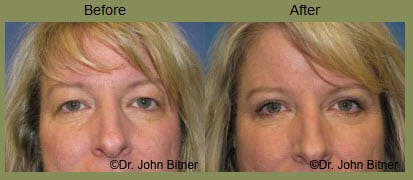
 Blepharoplasty, commonly known as eyelid surgery or eyelid lift is a procedure often part of facial rejuvenation by patients in Utah. Both the upper and lower eyelids can be separately addressed. Further, eyelid surgery can be divided into functional blepharoplasty and cosmetic blepharoplasty.
Blepharoplasty, commonly known as eyelid surgery or eyelid lift is a procedure often part of facial rejuvenation by patients in Utah. Both the upper and lower eyelids can be separately addressed. Further, eyelid surgery can be divided into functional blepharoplasty and cosmetic blepharoplasty.
The eyes is an area of the body that can be captivating. Much of a persons emotions, thoughts and expressions can be revealed through small and subtle changes. Eyes truly are the center piece of the face and the window to the soul.
As we age, changes occur around the eyes that convey a sense of tiredness, fatigue or even sickness. This can happen even after a good nights sleep and when the person feels otherwise refreshed. A common complaint of many patients who request surgery around the eyes is that they go to work after having slept 8 hours and feeling great, yet, people continue to ask, “did you not sleep well last night?” It has very little to do with sleep. These changes are usually genetically inherited. Indeed, there are 90 year olds that still don’t need thier eyes done and there are 16 year olds that already are showing sign of these changes. When genetically predisposed, those changes gradually worsen with age.

View Before & After Gallery
There are several approaches to surgery of the eyelids, known as blepharoplasty. Upper eyelid surgery requires precise placement of incisions within the supratarsal crease, a small horizontal crease in the upper eyelid, and out into one of the ”crows feet”. If the incision is too short it will fail to correct and even accentuate lateral hooding, a common problem with the upper eyes. Each persons creases, lines and amount of excess skin to be removed is unique and a careful mark, precise cuts and an artists vision is required. There are also several fatty pads surrounding the eyes that are divided into compartments. These fatty pads can be trimmed and tightened at the time of skin removal.
When addressing the lower eyelid, several different approaches are used. Incisions can be made on the inside of the eyelid (transconjunctival blepharoplasty), directly underneath the lashes (subcilliary blepharoplasty or skin-muscle blepharoplasty), or a combination of the two. The goal of the operation is to remove or reposition the excess fat, tighten the muscle layer and remove and tighten the extra skin.
The skin of the eyelid is the thinnest anywhere in the body. For this and other reasons, eyelid skin heals remarkably well. When the incisions are placed correctly, they heal so as to be virtually undetectable. A properly performed procedure should maintain lid postion while enhancing the eyes natural beauty and sparkle. A person with a properly performed blepharoplasty will appear to have eyes that are larger and the vivid colors seem more enhanced.
Schedule your consultation
Frequently Asked Questions About The Surgical Procedure
How long does it take to perform a blepharoplasty?
When addressing just the upper lid, both eyes takes about 45 minutes. If doing both the upper and lower lids, both eyes take 75 to 90 minutes.
What type of anesthesia is used for a blepharoplasty?
There are many choices for anesthesia. I have done a blepharoplasty under just local anesthesia in the office and have also done this under general anesthesia in the operating room. Generally, I like to use some type of sedation while injecting the numbing medication. This part of the operation stings and causes some anxiety due to the proximity to the eye. After the area is injected, the amount of sedation can be lightened and the patient is often completely awakened. I inject with a mixture of 2% lidocaine with epinephrine mixed with an enzyme called hyaluronidase. This enzyme helps the injected anesthesia to diffuse and distribute into the tissues preventing distortion. When this procedure is done in conjunction with other cosmetic facial procedures, some type of sedation is maintained throughout the operation.
How long does it take to recover from a blepharoplasty?
After surgery, there is usually some minor bruising and swelling. This will gradually decrease over the course of 7-10 days. Rarely, a small bruised area just below the eye will persist for 14 or more days. Sutures are kept in place for 7 days after surgery. The incision will have a slightly pink appearance that will fade over time. Even at one week after surgery, the incisions are hard to find. After 6-12 weeks, the incisions virtually disappear. There is no pain after surgery. In fact, many patients will awaken after surgery and ask before looking in the mirror, “did you even do anything?” This is because it doesn’t hurt and you really feel almost nothing. Pain is often a sign of a complication and should be reported immediately to your
doctor. Many people will simply put on a pair of sunglasses and get back into life. I do ask that my patients refrain from exercise and any vigorous physical activity for 14 days after surgery.
What are the risks of eyelid surgery?
Overall, blepharoplasty is a very safe operation and complications are few and far between. Possible complications include infection, bleeding, failure to correct the sagging skin, visible scarring, unacceptable cosmetic result, injury to the muscles around the eye causing double vision, abnormal scarring pulling the eyelid down, blindness and even death. While results of cosmetic surgery and any other surgery can not be guaranteed, overall complications are very rare and the majority of patients are extremely pleased with the result. I have never seen the majority of the complications mentioned.
Is a blepharoplasty covered by insurance?
Yes, there are situations where the insurance companies will get involved. This is termed a functional blepharoplasty. In some patients the skin of the upper eyelid gets to be very heavy and will begin to block off part of the persons vision. The patient will usually come into my office stating that they are having a hard time seeing things in the upper or peripheral field of view. There are other requirements including that the eyelid must touch or rest upon the upper eyelashes. When this is the case, the insurance companies require that we perform a visual field test which demonstrates that the eyelids are blocking off 30 degrees or more of the persons field of view. Photographs must be taken and a special submission to the insurance company is required. Once insurance approval is obtained, the surgery can be performed. It is important to remember that the principles of the surgery remain the same. It is still important to place the incisions in locations that will be completely hidden. The overall result should be completely natural and undetectable once the healing process is complete. Meticulous closure of the wound and conservative removal of fatty pads should be performed for an overall refreshed look while improving the persons field of view. Again, the purpose of a function blepharoplasty is to correct a functional problem (i.e. field of view is impaired) but should also improve the cosset appearance. It is very uncommon for insurance to be involved with lower eyelid surgery.
Read What Our Eyelid Surgery Patients Have to Say!
“I had an upper and lower blepharoplasty surgery because I’ve always been self-conscious about the bags under my eyes and the droopiness above my upper eyelids. I was referred to Dr. Bitner though my daughter and I could not be happier with the results! This surgery has taken years off my face, I no longer constantly look tired through my eyes. Doctor Bitner and his staff went above and beyond my expectations and I would highly recommend him.” — Hillary T.
“It’s been a little over a year since I had an upper blepharoplasty with Dr. Bitner, and my ULTRA-perfectionistic self couldn’t be happier with the result!” — Brandy G.
Read More Patient Reviews
Schedule a Blepharoplasty Consultation
To schedule a Blepharoplasty consultation or make an appointment with an Eyelid surgery specialist, please call us at (801) 525-8727 or fill out an online contact form and our office will be in touch with you. Thank you for choosing Bitner Facial Plastic Surgery in Layton, Utah!
Click Here To Contact Us

 Blepharoplasty, commonly known as eyelid surgery or eyelid lift is a procedure often part of facial rejuvenation by patients in Utah. Both the upper and lower eyelids can be separately addressed. Further, eyelid surgery can be divided into functional blepharoplasty and cosmetic blepharoplasty.
Blepharoplasty, commonly known as eyelid surgery or eyelid lift is a procedure often part of facial rejuvenation by patients in Utah. Both the upper and lower eyelids can be separately addressed. Further, eyelid surgery can be divided into functional blepharoplasty and cosmetic blepharoplasty.
